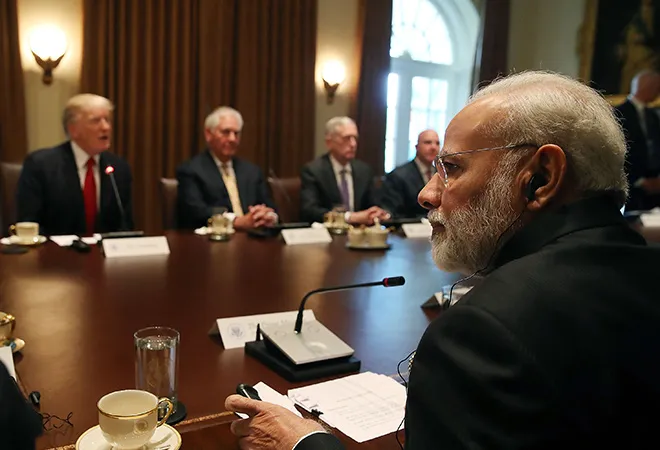
The US recently announced that it would end the privileges that India enjoys under the Generalised System of Preference (GSP) starting 5 June 2019. The GSP, implemented since 1974, is the largest and oldest US trade preference scheme and it allows duty-free imports for thousands of products from designated beneficiary countries. The move followed after criticism by the Trump administration that India was preventing equitable and reasonable access to its market. Trump administration has made a series of demands such as softening of price caps on medical equipment, removal of certain mandatory certifications for dairy product exports, changes to the e-commerce policy, etc.
The GSP scheme was adopted by the US under the provisions of Resolution 21 of the Second United Nations Conference on Trade and Development. It allows the developed countries to adopt a “generalised, non-reciprocal, non-discriminatory system of preferences in favour of the developing countries, including special measures in favour of the least developed nations.”
What is the likely impact of the withdrawal on exports? What should be India’s response to move forward given the structural nature of the GSP programme itself?
The GSP scheme was adopted by the US under the provisions of Resolution 21 of the Second United Nations Conference on Trade and Development (UNCTAD). It allows the developed countries to adopt a “generalised, non-reciprocal, non-discriminatory system of preferences in favour of the developing countries, including special measures in favour of the least developed nations.” This special and preferential treatment to developing countries is an exception to the Most Favoured Nation (MFN). India was the largest beneficiary of the programme in 2017 with USD 5.7 billion in exports to the US that were given duty-free entry into the US. Let us examine the likely impact of the withdrawal through the study of the following tables. Table 1 lists the top exports from India under the GSP programme for the previous five years and Table 2 lists the total exports from India to the USA for the same products with or without GSP.
Table 1: Top exports under the GSP programme from India to the USA ($million)
| Hs Num |
Description |
2014 |
2015 |
2016 |
2017 |
2018 |
| 29 |
Organic Chemicals |
548 |
504 |
633 |
792 |
821 |
| 39 |
Plastics and Articles thereof |
344 |
338 |
366 |
398 |
465 |
| 40 |
Rubber and Articles thereof |
85 |
86 |
100 |
139 |
167 |
| 42 |
Articles of Leather |
45 |
50 |
56 |
93 |
266 |
| 68 |
Articles of Stone, Plaster, Cement |
102 |
119 |
137 |
165 |
164 |
| 73 |
Articles of Iron or Steel |
482 |
526 |
429 |
477 |
562 |
| 84 |
Nuclear Reactors, Boilers, Machinery |
671 |
627 |
553 |
622 |
725 |
| 85 |
Electrical Machinery |
379 |
372 |
379 |
415 |
437 |
| 87 |
Vehicles and parts |
356 |
445 |
421 |
532 |
660 |
Table 2: Total exports from India to the USA ($million)
| Hs Num |
Description |
2014 |
2015 |
2016 |
2017 |
2018 |
| 29 |
Organic Chemicals |
2,250 |
2,018 |
2,014 |
2,177 |
2,451 |
| 39 |
Plastics and Articles thereof |
459 |
449 |
458 |
519 |
616 |
| 40 |
Rubber and Articles thereof |
372 |
354 |
359 |
419 |
515 |
| 42 |
Articles of Leather |
442 |
472 |
458 |
484 |
530 |
| 68 |
Articles of Stone, Plaster, Cement |
356 |
398 |
400 |
440 |
477 |
| 73 |
Articles of Iron or Steel |
1,216 |
1,245 |
919 |
1,367 |
1,266 |
| 84 |
Nuclear Reactors, Boilers, Machinery |
2,322 |
2,382 |
2,083 |
2,531 |
3,349 |
| 85 |
Electrical Machinery |
1,344 |
1,274 |
1,284 |
1,339 |
1,715 |
| 87 |
Vehicles and parts |
1,114 |
1,380 |
1,175 |
1,393 |
2,812 |
USA is one of the top trading partners of India amounting to about 16% of total Indian exports. It is a large export market for India. Table 3 shows the percentage of total exports to the USA, in the same categories, that would be affected if GSP is withdrawn. It is derived from the first two tables and it can be seen from Table 3 that it would be a significant part of the total exports. Products such as ‘Plastics and articles thereof’ — 75% of its export is covered under the GSP scheme and therefore its withdrawal will have a large impact on the sector. Similarly, the impact on iron and steel is almost 50%, with 50% of the products in the sector currently covered under the GSP scheme. Therefore, it is clear from the data that the impact of GSP withdrawal on Indian exports to the USA will be significant and felt across many sectors.
Table 3: Percentage of exports to the USA (under GSP)
| Hs Num |
Description |
2014 |
2015 |
2016 |
2017 |
2018 |
| 29 |
Organic Chemicals |
24% |
25% |
31% |
36% |
34% |
| 39 |
Plastics and Articles thereof |
75% |
75% |
80% |
77% |
75% |
| 40 |
Rubber and Articles thereof |
23% |
24% |
28% |
33% |
32% |
| 42 |
Articles of Leather |
10% |
11% |
12% |
19% |
50% |
| 68 |
Articles of Stone, Plaster, Cement |
29% |
30% |
34% |
38% |
34% |
| 73 |
Articles of Iron or Steel |
40% |
42% |
47% |
35% |
44% |
| 84 |
Nuclear Reactors, Boilers, Machinery |
29% |
26% |
27% |
25% |
22% |
| 85 |
Electrical Machinery |
28% |
29% |
30% |
31% |
25% |
| 87 |
Vehicles and parts |
32% |
32% |
36% |
38% |
23% |
In retaliation to the withdrawal, New Delhi has decided to impose retaliatory tariffs on 29 US products. Given the possible impact on the exports to the USA as seen in the data above, India should try to negotiate to restore the GSP benefits, although given the fact that it is a unilateral benefit that has been extended to India, India may have to offer resolution on some of the concerns raised by the US. The meeting between PM Modi and President Trump at the upcoming G20 meeting will give both sides the opportunity to sit down and talk and work out how best not to escalate the present tensions in the bilateral trade relations. Further, the government needs to extend support to the sectors that will be most affected by the withdrawal.
India should try to negotiate to restore the GSP benefits, although given the fact that it is a unilateral benefit that has been extended to India, India may have to offer resolution on some of the concerns raised by the US.
As a long term measure, it would make sense for India to follow a path that does not make it overtly reliant on such schemes from a developed country but instead to use any such benefits to improve the competitiveness of its products. The GSP has, since its inception, been used as a tool by the US to effect economic and policy changes in the beneficiary countries. In 1992, the GSP scheme was used by the US to exert pressure on India to extend patent protection to chemical and pharmaceutical products. Even in the current situation, the Indian government has pointed out that the GSP benefits cannot be used by US to advance its trade interests. This also violates the non-reciprocal clause of GSP as mentioned previously. In addition, the discretionary power enjoyed by the President to withdraw the scheme introduces uncertainty with respect to availing the benefits on a continued basis and also defeats the purpose of providing such concessions in the first place. Given these structural issues, this should be used as an opportunity to reduce reliance on such schemes. The unilateral nature of the scheme means that it is not a right of the beneficiary country and it cannot hope to enjoy such concessions for the long term.
Data used in the tables are courtesy USITC Tariff and Trade DataWeb.
The views expressed above belong to the author(s). ORF research and analyses now available on Telegram! Click here to access our curated content — blogs, longforms and interviews.




 PREV
PREV


